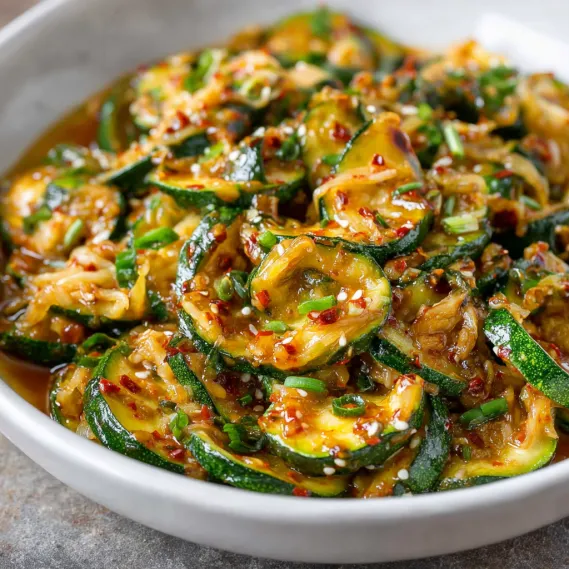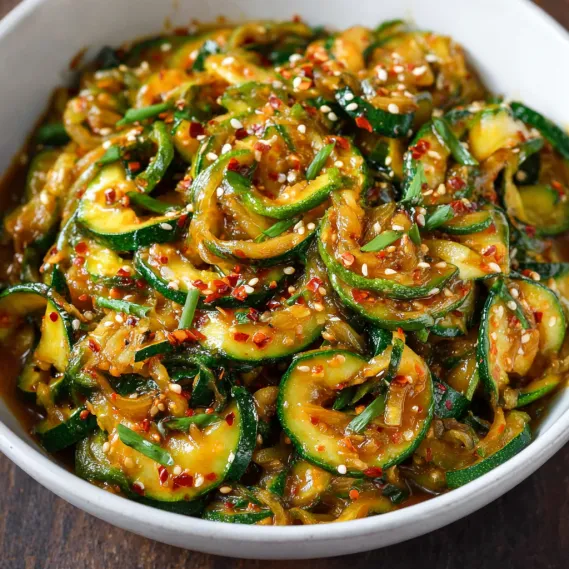 Pin
Pin
This refreshing Chinese zucchini recipe transforms simple vegetables into a nutty, spicy dish that balances raw freshness with bold Asian flavors. Whether served as a side or bulked up with protein for a main meal, it delivers incredible taste without cooking, preserving all the natural nutrients in each ingredient.
I discovered this recipe during a particularly scorching summer when turning on the stove felt like torture. My family was skeptical of raw zucchini at first, but now they request this zoodle dish weekly as a light dinner option.
Ingredients
- Zucchinis: 4, cut into noodles. Look for firm, medium sized zucchinis with unblemished skin for the best texture
- Salt: 1 teaspoon. Essential for drawing out excess moisture from the zucchini
- Garlic cloves: 2, finely chopped. Fresh is critical here as it provides the aromatic foundation
- Coconut aminos: 2 tablespoons. Adds umami depth while keeping the dish gluten free
- Tahini or peanut/almond butter: 2 tablespoons. Creates the creamy texture and nutty flavor base
- Sesame oil: 1 tablespoon. Provides authentic Asian flavor notes and rich mouthfeel
- Medium or mild chili powder: 2-3 teaspoons. Adjustable depending on your heat preference
- Chili oil: 2 teaspoons. Adds a complex spicy element with slight smokiness
- Honey or maple syrup: 2 teaspoons. Optional but balances the heat with gentle sweetness
- Optional garnishes: Toasted sesame seeds and green onions add texture and fresh flavor
Step-by-Step Instructions
- Prepare The Zoodles:
- Cut your zucchini into noodle shapes using a spiralizer, mandoline slicer, or knife. If using a spiralizer, cut the long strands into more manageable lengths with scissors. This makes both mixing and eating much easier later on.
- Salt And Drain:
- Toss your zucchini noodles thoroughly with salt and place them in a colander over the sink or a bowl. Let them sit for 30 minutes to release excess moisture. This crucial step prevents your final dish from becoming watery and diluting the flavors of your sauce.
- Create The Sauce:
- While the zoodles are draining, combine garlic, coconut aminos, tahini or nut butter, sesame oil, chili powder, chili oil, and honey or maple syrup in a large mixing bowl. Whisk thoroughly until you achieve a smooth, uniform consistency. The sauce should be thick enough to coat a spoon but still pourable.
- Combine And Finish:
- After the 30 minute draining period, gently squeeze handfuls of zoodles to remove additional moisture. Be careful not to squeeze too aggressively as this can damage the delicate structure. Add the drained zoodles to your sauce mixture and toss thoroughly until every strand is evenly coated. Garnish with toasted sesame seeds and sliced green onions if desired.

The tahini is truly the secret weapon in this recipe. While many Chinese dishes use peanut butter, I find tahini provides a more sophisticated, nutty flavor that complements the zucchini perfectly. The first time I brought this to a family gathering, my uncle who claims to hate vegetables had three servings before asking what was in it.
Making It Ahead
This recipe actually benefits from being made in advance. The flavors meld together beautifully in the refrigerator, with the zucchini absorbing the sauce components while still maintaining some crunch. I often prepare it the night before serving for optimal flavor development. Just give it a quick toss before serving to redistribute the sauce that may have settled at the bottom of your container.
Turning It Into A Meal
While delicious on its own, this dish transforms easily into a complete meal. My favorite additions include diced cooked chicken breast, pan seared shrimp, or cubed firm tofu for protein. For a heartier version, add thinly sliced bell peppers, shredded carrots, or bean sprouts. The versatility of the sauce complements almost any addition you might imagine, making it perfect for using up vegetables in your refrigerator.
Traditional Inspiration
This recipe draws inspiration from Sichuan cold noodle dishes, particularly those featuring sesame and chili oil. The traditional versions typically use wheat noodles, but this zucchini adaptation provides a lighter, more nutritious alternative while maintaining authentic flavor profiles. In Sichuan cuisine, the balance of nutty, spicy, slightly sweet, and savory elements creates the characteristic flavor complexity that makes these dishes so craveable.
Common Questions About This Recipe
- → Can this be served warm or cold?
This dish is often enjoyed cold for a fresh crunch, but you can also quickly stir fry for a warm variation.
- → What tools work best for making zoodles?
A spiralizer yields even zucchini noodles, but a mandoline slicer or careful knife work also makes great results.
- → Are there options for the nutty sauce base?
Tahini, peanut butter, or almond butter all work well. Each one brings a slightly different flavor profile.
- → How do I prevent soggy zucchini noodles?
Lightly salt and drain the noodles, then gently squeeze out excess moisture before mixing with the sauce.
- → Can proteins be added for a complete meal?
Absolutely—add diced chicken, tofu, or shrimp to make this dish more substantial and satisfying.
- → How spicy is the finished dish?
Spice level is adjustable; use chili powder and oil to your taste for mild or bolder heat.
